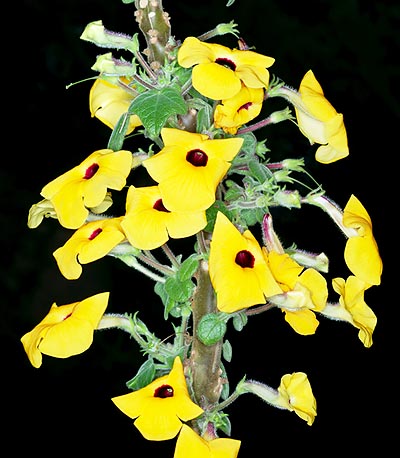Family : Pedaliaceae

Text © Pietro Puccio

English translation by Mario Beltramini

Unusual plant, may reach the 6 m. Doesn’t stand the cold © Mazza
The Uncarina grandidieri (Baill.) Stapf (1895) is native to the arid deciduous forests of Magadascar.
The name of the genus is the diminutive of Uncaria, genus with which some affinities do exist.
The species is honoured to the French naturalist and explorer Alfred Grandidier (1836-1921).
Common names: farehitra, farehitsy (Malagasy); succulent sesame, mouse trap tree (English); Mausefallen-Baum (German).
Shrub or small tree tall up to about 6 m (less in cultivation), deciduous, with an up to 30 cm diameter succulent stem and underground caudex.
Cordate-lobate, tomentose, leaves smelling mouldy when rubbed 5-7 cm broad solitary flowers, with a bright yellow colour, with a dark purple throat.
The fruits are capsules provided with thorns with hooked beards, particularly treacherous, which facilitate the spreading of the plant.
Caudiciform appreciated by the collectors, due to its long lasting showy blooming and to its rather easy cultivation.
It prefers alkaline draining soils, and regular watering during the vegetative time, which are to be interrupted for the whole resting period; the best exposition is the full sun or a light shade.
Even if during the resting time it can bear some brief excursion around the 0°C, if completely in the dry, as a rule it is good to maintain a temperature not lower than 14-16°C.
Synonyms: Harpagophytum dimidiatum - Baill. (1877); Harpagophytum grandidieri - Baill. (1887).
→ To appreciate the biodiversity within PEDALIACEAE family please click here.
